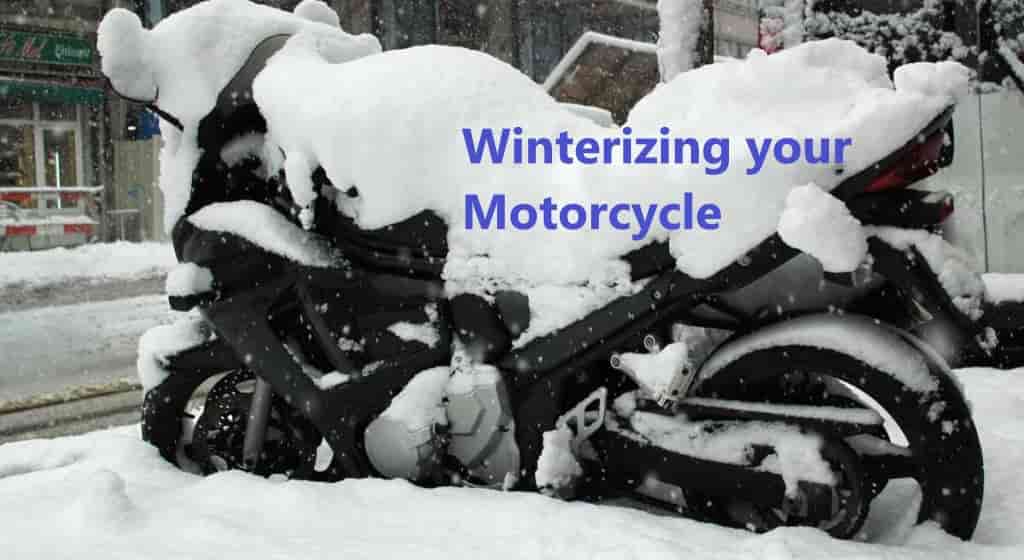You can ensure your bike is ready for riding when the weather warms up by following these steps and Tips on Winterizing your Motorcycle correctly has been discussed here. Even though the riding season is longer in our area compared to other places, winter is here whether you like it or not. Some riders here keep their bikes in storage during the coldest months and keep riding through the winter. You can bet your bike will spend more time in the garage than usual unless you have no other transportation.

Those of you who wish to ride during the winter are liable to have problems if you drape an old sheet over our bikes and call it good. The fuel system and battery should be attended to at a minimum. Your battery can go dead and your gas can gum up when you park your bike for an extended period of time.
Importance of Winterizing your Motorcycle
The cooling system and gas tank of your bike may become blocked if you do not winterize your bike and simply put it in storage for a long period of time. It can lead to brittle chains, cracked tires, and a dead battery if your bike’s oil becomes sluggish over time.
It will be easier to run your bike on the first day of spring or during this warm winter day if you winterize your bike properly before putting it into storage.
01. Bike Riding
It helps to run the engine and ride your bike so that any contaminants or water in the oil are driven off. Furthermore, the chain will be heated, making lubrication easier.
02. Battery Checking
After a few months, a traditional lead-acid battery will likely be too weak to start your bike if left unattended. In order for the battery to stay topped up and ready to crank, it’s really important to dock it up with a smart charger. You should make sure you buy a smart charger that only feeds current to the battery when it’s needed, since there are lots of chargers and maintainers out there.
You can disconnect the negative terminal of a lithium-ion battery if your bike has one. It is highly unlikely that lithium-ion batteries will self discharge over a year or more due to their extremely low self discharge rate. When storing your bike without access to a power source, then you will want to remove the battery and plug it into an indoor trickle charger.
03. Engine Checking
Those who advocate adding fresh oil in the fall before storage and in the spring after storage are overkill. If you are more than halfway toward your next scheduled oil change, do it now if you don’t want dirty oil sitting in the engine all winter. By doing this, you will be able to ride in the spring with fresh engine oil bathing the engine internals.
Make sure the oil is topped up if it is fairly fresh for the motorcycle engine.
04. Tire Checking
To avoid flat spots, make sure your motorcycle tires are inflated properly & prop the bike up on track stands, as this will prevent the tires from being loaded.
The only way to store a bike properly in winter is to use a center stand. Otherwise, purchase a set of stands, as they are useful for performing regular maintenance on your bike, including changing the oil and lubing the chain. Mark your tires with chalk if it’s too late to avoid flat spots and roll the bike forward or backward.
05. Check Your Motorcycle Fuel
It is pretty easy to prevent a tank full of foul smelling swill. If your bike has carburetors and a petcock, you can easily drain its fuel system. It is actually not that easy to empty most modern bikes because they are fuel injected. Fuel stabilizers keep gasoline from going bad and neutralize the ethanol in gasoline so it doesn’t harm your fuel system.
06. Gas Tank Filling
Fuel systems are sometimes drained completely by some people. In order to prevent clogging, the carbs and tank are drained, as well as the fuel. It is very inconvenient to physically remove the fuel tank and pump out all the fuel from most modern bikes, which use fuel injection and do not have easy ways to clear the tank.
The alternative is to fill up the tank completely so that any air or water that is present will be drained, as these are the main components that make your oil dirt free.
07. Chain Lube
You must treat the chain on your bicycle unless it is an electric bike. An easy way to lubricate a warm chain is to apply a water based lubricant to it at this stage. By using heat, the lube is drawn into the O rings, the links, and the rollers and is easily spread around them. Winter prevents rust and salt buildup on your chain with lubrication.
08. Fogging Oil
The lock is only required if the bike is going to be stored for a long period of time. Lubricating the inside of the motor is what fogging the cylinders means. The spark plugs must be removed first, and fogging oil has to be applied.
Foaming oil works similarly to an aerosol, creating a cloud of lubricant inside the spark plug hole and protecting the engine’s internal components. In this case, make sure you plan to spend at least six to eight months without riding your bike.
09. Washing & Waxing
Your bike is probably covered in dirt, dust, grease, and bird crap. Using bike specific washes, you can prevent damage to your bike’s finish by giving it a good wax and wash.
Your bike should be washed completely, dried, and then waxed to seal the finish. Polishing chrome, paint, and aluminum parts with wax keeps them looking their best.
Using wax will keep your bike from corroding, and your bike will look good coming into spring.
10. Fluid Replacement
You are referring to your engine oil, transmission fluid, and primary fuel when you mention fluids. These fluids can go bad if you don’t maintain them regularly, like tank fuel.
It is possible for your internal transmission components and your engine to be damaged by gummy or mucky oil. The best thing to do is to replace all of these fluids before storing your bike away.
Take the coolant out of the radiator if your bike is liquid-cooled. Long-term idling of coolants can cause them to become acidic. Radiators and cooling systems can be severely damaged by acidic coolants.
11. Ignoring Pest Problem
If your motor has doors and air box inlet, you may want to block the openings with heavy plastic and rubber band or zip ties. By doing so, you will discourage rodents from nesting in your air box and you will keep moisture out, which could potentially corrode valves and cylinder walls.
12. Do not Park the Bike Outside
The final thing you can give your bike a warm blanket to sleep under while it sleeps through the winter. Dust can be kept off your bike with an old sheet, but cotton tends to attract moisture and might mildew, so you are better off with a synthetic or tarp bike cover.
